kottke.org posts about usa
According to CEO Tim Cook, Apple will start making some of its computers entirely in the US.
Apple CEO Tim Cook announced one of the existing Mac lines will be manufactured exclusively in the United States next year. Mac fans will have to wait to see which Mac line it will be because Apple, widely known for its secrecy, left it vague. Cook’s announcement may or may not confirm recent rumors in the blogosphere sparked by iMacs inscribed in the back with “Assembled in USA.”
Well, those iMac pretty clearly state they are assembled in the US. And look for this “made in the USA” thing to turn into a trend…I think companies are finding that making stuff in the US is not as expensive as everyone thinks it is.
Update: BusinessWeek has a long interview with Cook about US manufacturing, among many other topics.
It’s not known well that the engine for the iPhone and iPad is made in the U.S., and many of these are also exported-the engine, the processor. The glass is made in Kentucky. And next year we are going to bring some production to the U.S. on the Mac. We’ve been working on this for a long time, and we were getting closer to it. It will happen in 2013. We’re really proud of it. We could have quickly maybe done just assembly, but it’s broader because we wanted to do something more substantial. So we’ll literally invest over $100 million. This doesn’t mean that Apple will do it ourselves, but we’ll be working with people, and we’ll be investing our money.
To answer the question, “If every state of the USA declared war against each other, which would win?” Quora user Jon Davis went way in-depth writing “the accounts of the Second American Civil War, also known as the Wars of Reunification and the American Warring States Period.” It’s sort of a mix between World War Z (oral histories) and the post on Reddit being turned into a movie (realistic seeming discussion of military action). I am a sucker for this kind of fictionalized future-history stuff.
First came a period of massive migration back to the homelands. Facing the newly invented discrimination that will be created many felt the need to go back to their own people. While the individual states retained all military assets they couldn’t control the individuals who fight. A Texas Marine stationed in California, would not fight for California. A soldier in New York would not fight against their home in Virginia and a sailor in Houston would not fight against their home state of Florida. The warriors returned to their home states and the states had to re-consider that when they measured troop strength of their new nations. Ultimately, they measured troop strength by how much of the population would return home.
(via Stellar)
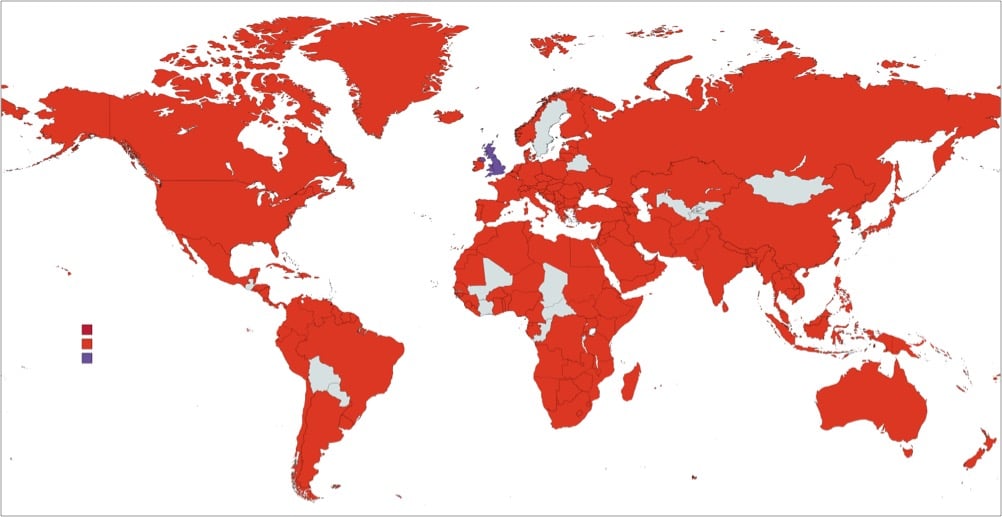
Of the current 200 nations in the world, the British have invaded all but 22 of them. The lucky 22 include Sweden, Luxembourg, Mongolia, Bolivia, and Belarus. The full analysis is available in Stuart Laycock’s book, All the Countries We’ve Ever Invaded.
Stuart Laycock, the author, has worked his way around the globe, through each country alphabetically, researching its history to establish whether, at any point, they have experienced an incursion by Britain.
Only a comparatively small proportion of the total in Mr Laycock’s list of invaded states actually formed an official part of the empire.
The remainder have been included because the British were found to have achieved some sort of military presence in the territory — however transitory — either through force, the threat of force, negotiation or payment.
Incursions by British pirates, privateers or armed explorers have also been included, provided they were operating with the approval of their government.
The US currently has military personnel stationed in all but 43 countries.
For instance, as of Sept. 30, 2011, there were 53,766 military personnel in Germany, 39,222 in Japan, 10,801 in Italy and 9,382 in the United Kingdom. That makes sense. But wait, scanning the list, you also see nine troops in Mali, eight in Barbados, seven in Laos, six in Lithuania, five in Lebanon, four in Moldova, three in Mongolia, two in Suriname and one in Gabon.
But the presence in most of those countries is due to diplomatic usage of military personnel. (thx, aaron)
The Dust Bowl is a four-hour documentary by Ken Burns airing on PBS starting this weekend.
The Dust Bowl chronicles the worst man-made ecological disaster in American history, in which the frenzied wheat boom of the “Great Plow-Up,” followed by a decade-long drought during the 1930s nearly swept away the breadbasket of the nation. Vivid interviews with twenty-six survivors of those hard times, combined with dramatic photographs and seldom seen movie footage, bring to life stories of incredible human suffering and equally incredible human perseverance. It is also a morality tale about our relationship to the land that sustains us — a lesson we ignore at our peril.
You can watch the first five minutes of the film on the PBS site.
It was not my intent to be so politically oriented this morning but here we are. This is a chart that tracks the ideologies of the Democratic and Republican members of Congress from 1789 to 2010. As you can see, the shift away from the center by the Republicans since 1975 is unprecedented, perhaps matched only by the shift toward the center by the Democrats beginning in 1921 and ending in 1945.

This reminds me of a timeline created circa 1880 for a book called Conspectus of the History of Political Parties and the Federal Government:
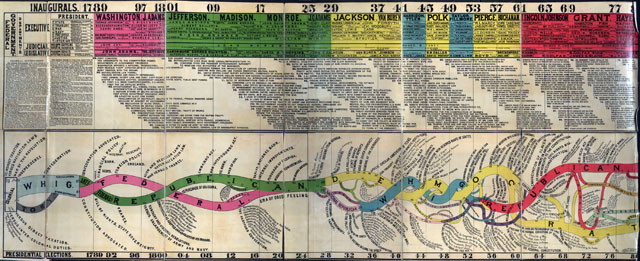
Bigger version here. (via @joecarryon)
Today marks the 50th anniversary of the beginning of the Cuban Missile Crisis. In commemoration of the event, the JFK Presidential Library & Museum presents Clouds Over Cuba, a tense and engaging presentation on the Crisis and, even more strikingly, a dramatization on what might have happened had things gone differently. This is really well done and worth taking 10-15 minutes to watch/listen. (via @alexismadrigal)
A group of citizens is attempting to change Columbus Day to Exploration Day. Columbus Day has always been a weird holiday, what with CC’s slavery and genocide and all, so this seems like a good idea to me. Maggie Koerth-Baker makes the case over at Boing Boing.
The logic is quite neat. Columbus Day is about one guy and the (actually untrue) claim that he was the first person to discover America. Inherently, that’s pretty Euro-centric, which is a big part of why it sits awkwardly in a pluralistic country. But exploration is inclusive. The ancestors of Native Hawaiians were explorers who crossed the ocean. The ancestors of Native Americans explored their way across the Bering land bridge and then explored two whole continents. If you look at the history of America, you can see a history of exploration done by many different people, from many different backgrounds. Sometimes we’re talking about literal, physical exploration. Other times, the exploring is done in a lab. Or in space. But the point is clear: This country was built on explorers. And it needs explorers for the future.
If you want to help out, sign this petition to Congress or this one to the White House.
Starting with a blank map of the US, the object is to place each state in its proper place.
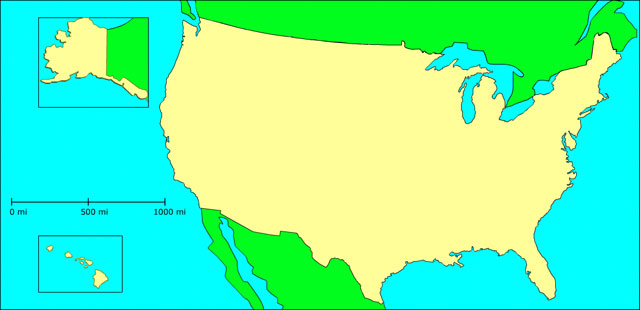
My average error was 8 miles. A better test would be to start each state with the blank map…placing Colorado in the western part of the country without any guide is much tougher than doing it last. (via @notrobwalker)
In the New Yorker, Elizabeth Kolbert says that, “with the exception of the imperial offspring of the Ming dynasty and the dauphins of pre-Revolutionary France”, American kids might be the most spoiled kids in the history of the world. Strong words but not without merit.
How did parents in different cultures train young people to assume adult responsibilities? In the case of the Angelenos, they mostly didn’t. In the L.A. families observed, no child routinely performed household chores without being instructed to. Often, the kids had to be begged to attempt the simplest tasks; often, they still refused. In one fairly typical encounter, a father asked his eight-year-old son five times to please go take a bath or a shower. After the fifth plea went unheeded, the father picked the boy up and carried him into the bathroom. A few minutes later, the kid, still unwashed, wandered into another room to play a video game.
In another representative encounter, an eight-year-old girl sat down at the dining table. Finding that no silverware had been laid out for her, she demanded, “How am I supposed to eat?” Although the girl clearly knew where the silverware was kept, her father got up to get it for her.
In a third episode captured on tape, a boy named Ben was supposed to leave the house with his parents. But he couldn’t get his feet into his sneakers, because the laces were tied. He handed one of the shoes to his father: “Untie it!” His father suggested that he ask nicely.
“Can you untie it?” Ben replied. After more back-and-forth, his father untied Ben’s sneakers. Ben put them on, then asked his father to retie them. “You tie your shoes and let’s go,” his father finally exploded. Ben was unfazed. “I’m just asking,” he said.
From Quora, some interesting answers to the question “What facts about the United States do foreigners not believe until they come to America?” The economics of food was a popular response:
Fruit and vegetable prices, compared to fast food prices:
A bag of grapes: $6
A box of strawberries: $7
1lb tomatoes: $3
McChicken: $1
Big Mac : $1 ( I think. I don’t go to McDonalds though)
HOW DOES THAT EVEN WORK?
At the same time, there are things that you wouldn’t associate with first-world countries:
Religious fanaticism
It is hard to believe that a first-world country has non-progressive ideologies, especially that hurt women (the vaginal probes and other abortion related woes). Not only that, the belief in Earth’s age, talking snake etc. Being from India, it is even harder for me to understand this. I expected US to be more progressive. It is not as crazy as back in India but still something that I think is enough to be detrimental to the progress.
Others are pleasantly surprised:
Many Indians are very surprised to find out that there are large numbers of Americans who actually love their parents and siblings and wives and children and have normal, healthy relationships with them. Our media has them convinced that all Americans are very self-centered people who throw their kids out of their homes after high school, don’t care for their parents, and divorce their spouses. And, I swear, it is literally true that many Indians do not believe that this is not true until they have been to the US and seen examples of good healthy family relationships themselves. I have had heated arguments with people who’ve never been to the US, but can give lectures on how screwed up family values in the US are.
But we could also use some improvement:
There actually is an accepted piece of clothing called a ‘wife-beater’.
(via @alexandrak)
Max Fisher has a piece at The Atlantic about what travel guidebooks tell foreign visitors to the US.
Politics get heavy treatment in the books, as do the subtleties of discussing them, maybe more so than in any other guidebook I’ve read (what can I say, it’s an addiction). Lonely Planet urges caution when discussing immigration. “This is the issue that makes Americans edgy, especially when it gets politicized,” they write, subtly suggesting that some Americans might approach the issue differently than others. “Age has a lot to do with Americans’ multicultural tolerance.”
Rough Guide doesn’t shy away from the fact that many non-Americans are less-than-crazy about U.S. politics and foreign policy, and encouragingly notes that many Americans are just as “infuriated” about it as visitors might be. Still, it warns that the political culture saturates everything, and that “The combination of shoot-from-the-hip mentality with laissez-faire capitalism and religious fervor can make the U.S. maddening at times, even to its own residents.”
Having recently published a book about Paris, France, Rosecrans Baldwin visited a number of towns named Paris around the US to see how Americans perceive the French here in 2012. Here’s part one of his report.
The survey has eight questions ranging from general opinions to particular trivia. For example, “Whose side was France on during the American Revolutionary War?”
Sixty-six percent of respondents get it right: our side. Twenty percent are wrong. Incorrect answers include “the British,” “England,” “the opposite side,” and, oddly, “the French.” Other responses: “History was not my class in school — I hate it,” and “I am averse.” My favorite comes from a gas station attendant in Lexington, Ky., who writes: “I refuse to answer the rest of this survey. I love the French language. I have had many French friends.”
One guy in a parking lot outside a Dallas strip club says, “This has got to be a trick question.” And there’s another person, at Phoenix Sky Harbor International Airport, who will ask me, “You mean our American Revolutionary War?” Which appears to be a general concern — of the 55 people, at least 10 ask me to which American Revolution I am referring. Two people say, “But we didn’t have a revolution.”
The Morning News is serializing the other parts of this story all this month but you can get the whole thing right now on the Kindle.
Lakhdar Boumediene was imprisoned in the Guantanamo Bay detention camp for seven years on no charge and with no trial.
On Wednesday, America’s detention camp at Guantanamo Bay will have been open for 10 years. For seven of them, I was held there without explanation or charge. During that time my daughters grew up without me. They were toddlers when I was imprisoned, and were never allowed to visit or speak to me by phone. Most of their letters were returned as “undeliverable,” and the few that I received were so thoroughly and thoughtlessly censored that their messages of love and support were lost.
This is deeply deeply shameful.
In a piece for Vanity Fair, Kurt Andersen argues that for the first time in recent history, American pop culture (fashion, art, music, design, entertainment) hasn’t changed dramatically in the past 20 years.
Since 1992, as the technological miracles and wonders have propagated and the political economy has transformed, the world has become radically and profoundly new. (And then there’s the miraculous drop in violent crime in the United States, by half.) Here is what’s odd: during these same 20 years, the appearance of the world (computers, TVs, telephones, and music players aside) has changed hardly at all, less than it did during any 20-year period for at least a century. The past is a foreign country, but the recent past — the 00s, the 90s, even a lot of the 80s — looks almost identical to the present. This is the First Great Paradox of Contemporary Cultural History.
Think about it. Picture it. Rewind any other 20-year chunk of 20th-century time. There’s no chance you would mistake a photograph or movie of Americans or an American city from 1972-giant sideburns, collars, and bell-bottoms, leisure suits and cigarettes, AMC Javelins and Matadors and Gremlins alongside Dodge Demons, Swingers, Plymouth Dusters, and Scamps-with images from 1992. Time-travel back another 20 years, before rock ‘n’ roll and the Pill and Vietnam, when both sexes wore hats and cars were big and bulbous with late-moderne fenders and fins-again, unmistakably different, 1952 from 1972. You can keep doing it and see that the characteristic surfaces and sounds of each historical moment are absolutely distinct from those of 20 years earlier or later: the clothes, the hair, the cars, the advertising — all of it. It’s even true of the 19th century: practically no respectable American man wore a beard before the 1850s, for instance, but beards were almost obligatory in the 1870s, and then disappeared again by 1900. The modern sensibility has been defined by brief stylistic shelf lives, our minds trained to register the recent past as old-fashioned.

This map of the US was made by David Imus — he worked seven days a week for two years on it — and it won the Best of Show award at the Cartography and Geographic Information Society competition for 2010. Here’s why.
According to independent cartographers I spoke with, the big mapmaking corporations of the world employ type-positioning software, placing their map labels (names of cities, rivers, etc.) according to an algorithm. For example, preferred placement for city labels is generally to the upper right of the dot that indicates location. But if this spot is already occupied — by the label for a river, say, or by a state boundary line — the city label might be shifted over a few millimeters. Sometimes a town might get deleted entirely in favor of a highway shield or a time zone marker. The result is a rough draft of label placement, still in need of human refinement. Post-computer editing decisions are frequently outsourced-sometimes to India, where teams of cheap workers will hunt for obvious errors and messy label overlaps. The overall goal is often a quick and dirty turnaround, with cost and speed trumping excellence and elegance.
By contrast, David Imus worked alone on his map seven days a week for two full years. Nearly 6,000 hours in total. It would be prohibitively expensive just to outsource that much work. But Imus — a 35-year veteran of cartography who’s designed every kind of map for every kind of client — did it all by himself. He used a computer (not a pencil and paper), but absolutely nothing was left to computer-assisted happenstance. Imus spent eons tweaking label positions. Slaving over font types, kerning, letter thicknesses. Scrutinizing levels of blackness. It’s the kind of personal cartographic touch you might only find these days on the hand-illustrated ski-trail maps available at posh mountain resorts.
Update: The map is now in its fourth version of the second edition, updated in Sept 2022. I updated the image above to a snippet of the newest map.
Fuck Yeah Made in USA is a collection of videos showcasing products that are made in the US. These are chock full of “how things are made” goodness.
From Lapham’s Quarterly, Christopher Hitchens on capital punishment in America.
Since then no country has been allowed to apply for membership or association with the European Union without, as a precondition, dismantling its apparatus of execution. This has led states like Turkey to forego what was once a sort of national staple. The United Nations condemns capital punishment-especially for those who have not yet reached adulthood-and the Vatican has come close to forbidding if not actually anathematizing the business. This leaves the United States of America as the only nation in what one might call the West, that does not just continue with the infliction of the death penalty but has in the recent past expanded its reach. More American states have restored it in theory and carried it out in practice, and the last time the Supreme Court heard argument on the question it was to determine whether capital punishment should be inflicted for a crime other than first-degree murder (the rape of a child being the suggested pretext for extension).
Hitchens, as you may have guessed, pins much of the blame on religion…after all, the US is the most (or only?) fundamentalist country in the West. (via ★interesting-links)
For this coming weekend’s NY Times Magazine, journalist Jose Antonio Vargas shares the story of his Life as an Undocumented Immigrant.
One day when I was 16, I rode my bike to the nearby D.M.V. office to get my driver’s permit. Some of my friends already had their licenses, so I figured it was time. But when I handed the clerk my green card as proof of U.S. residency, she flipped it around, examining it. “This is fake,” she whispered. “Don’t come back here again.”
Vargas won a Pulitzer and wrote this article about Mark Zuckerberg for the New Yorker. I hope he can work out a way to stay in the United States…we need more people like him on our team.
The US military is often thought of by many Americans as being identified with conservative politics, making it an unlikely blueprint for progressive reform. But a recent pair of articles demonstrates that the US as a whole might have something to learn about the US Armed Forces’ liberal leanings. In the NY Times, Nicholas Kristof argues that the US military’s universal healthcare and focus on education is worth looking at as a model:
The military is innately hierarchical, yet it nurtures a camaraderie in part because the military looks after its employees. This is a rare enclave of single-payer universal health care, and it continues with a veterans’ health care system that has much lower costs than the American system as a whole.
Perhaps the most impressive achievement of the American military isn’t its aircraft carriers, stunning as they are. Rather, it’s the military day care system for working parents.
While one of America’s greatest failings is underinvestment in early childhood education (which seems to be one of the best ways to break cycles of poverty from replicating), the military manages to provide superb child care. The cost depends on family income and starts at $44 per week.
And the WSJ recently covered remarks made by Sgt. Maj. Micheal Barrett, the top non-commissioned officer in the Marine Corps and general all-around hardass, about gays in the military:
Article 1, Section 8 of the Constitution is pretty simple, It says, ‘Raise an army.’ It says absolutely nothing about race, color, creed, sexual orientation. You all joined for a reason: to serve. To protect our nation, right? How dare we, then, exclude a group of people who want to do the same thing you do right now, something that is honorable and noble? … Get over it. We’re magnificent, we’re going to continue to be. … Let’s just move on, treat everybody with firmness, fairness, dignity, compassion and respect. Let’s be Marines.
Now that’s some semper fi I can get behind. (thx, meg)
This is an amazing statement:
For the second year in a row, the U.S. military has lost more troops to suicide than it has to combat in Iraq and Afghanistan.
Always a fun read: The Beast’s list of the 50 most loathsome Americans of 2010. The idiot Alaskan lady is a mere sixth on the list; #1 is “you”:
Your brain’s been cobbled together over millions of years of blind evolution and it shows. You’re clumsy, stupid, weak and motivated by the basest of urges. Your MO is both grotesquely selfish and unquestionably deferential to questionable authority. You’re not in control of your life. You wear your ignorance like a badge of honor and gleefully submit to oppression, malfeasance and kleptocracy. You will buy anything. You will believe anything. You believe that evolution is a matter of belief. You likely scrolled down to #1, without reading the rest, because you’re an impatient, semi-literate Philistine who’s either unable or unwilling to digest more than 140 characters at a time.
Before looking, see if you can guess the only US state currently without snow on the ground. The answer, from the NY Times:
With the arrival of snow in New York and the unusually severe storm in the South - which dumped more than a foot of snow in some areas — the National Weather Service said an unusual nationwide occurrence had taken place. There was now snow on the ground in all 50 states - including Hawaii, where snow fell on a volcano — except for Florida.
Dorothy Gambrell looked up all of the state names on Google and made a map of what the autocomplete suggestions were. Here’s part of it:
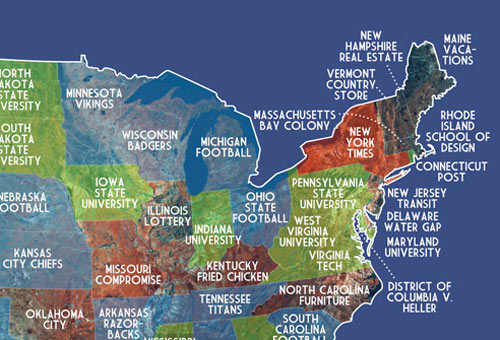
Lots of sports and schools.
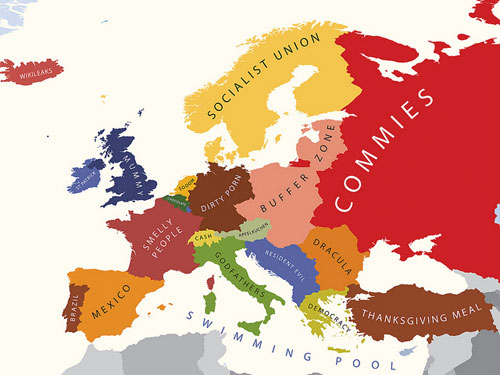
Larger version here. Other stereotype maps are available, including Europe According to Bulgaria and Europe According to Gay Men.
Vanity Fair has a really interesting but depressing look at how The President of the United States spends a typical day navigating the upfuckedness of national American politics and its capital, Washington DC — which Rahm Emanuel calls Fucknutsville.
We think of the presidency as somehow eternal and unchanging, a straight-line progression from 1 to 44, from the first to the latest. And in some respects it is. Except for George Washington, all of the presidents have lived in the White House. They’ve all taken the same oath to uphold the same constitution. But the modern presidency — Barack Obama’s presidency — has become a job of such gargantuan size, speed, and complexity as to be all but unrecognizable to most of the previous chief executives. The sheer growth of the federal government, the paralysis of Congress, the systemic corruption brought on by lobbying, the trivialization of the “news” by the media, the willful disregard for facts and truth — these forces have made today’s Washington a depressing and dysfunctional place. They have shaped and at times hobbled the presidency itself.
For much of the past half-century, the problems that have brought Washington to its current state have been concealed or made tolerable by other circumstances. The discipline of the Cold War kept certain kinds of debate within bounds. America’s artificial “last one standing” postwar economy allowed the country to ignore obvious signs of political and social decay. Wars and other military interventions provided ample distraction from matters of substance at home. Like many changes that are revolutionary, none of Washington’s problems happened overnight. But slow and steady change over many decades — at a rate barely noticeable while it’s happening — produces change that is transformative. In this instance, it’s the kind of evolution that happens inevitably to rich and powerful states, from imperial Rome to Victorian England. The neural network of money, politics, bureaucracy, and values becomes so tautly interconnected that no individual part can be touched or fixed without affecting the whole organism, which reacts defensively. And thus a new president, who was elected with 53 percent of the popular vote, and who began office with 80 percent public-approval ratings and large majorities in both houses of Congress, found himself for much of his first year in office in stalemate, pronounced an incipient failure, until the narrowest possible passage of a health-care bill made him a sudden success in the fickle view of the commentariat, whose opinion curdled again when Obama was unable, with a snap of the fingers or an outburst of anger, to stanch the BP oil spill overnight. And whose opinion spun around once more when he strong-armed BP into putting $20 billion aside to settle claims, and asserted presidential authority by replacing General Stanley McChrystal with General David Petraeus. The commentariat’s opinion will keep spinning with the wind.
(via waxy)
A very nice US currency redesign by Dowling Duncan.
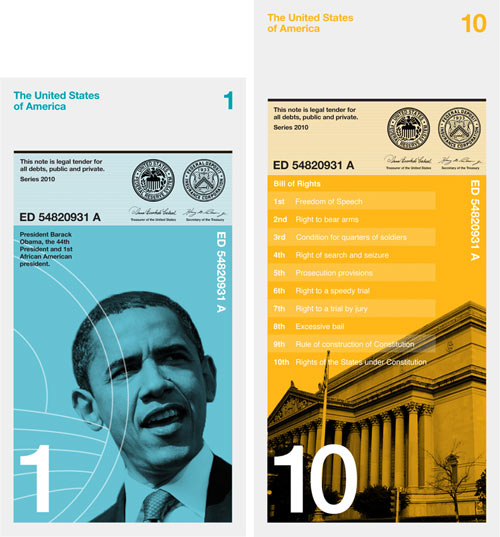
When we researched how notes are used we realized people tend to handle and deal with money vertically rather than horizontally. You tend to hold a wallet or purse vertically when searching for notes. The majority of people hand over notes vertically when making purchases. All machines accept notes vertically. Therefore a vertical note makes more sense.
The note imagery relates to the value of each note:
$1 - The first African American president
$5 - The five biggest native American tribes
$10 - The bill of rights, the first 10 amendments to the US Constitution
$20 - 20th Century America
$50 - The 50 States of America
$100 - The first 100 days of President Franklin Roosevelt.
Needs more guilloche but other than that: fire up the presses.
The story of the emigration of Morris Moel and his family from the Ukraine in the 1910s/20s demonstrates what an amazing pull America then had as the land of opportunity.
My father was here [in the USA]. He came in 1913. We didn’t hear from him for many many years during World War I, and after this the revolution in Russia. Things were terrible. So we didn’t hear from my father for 12 or 13 years. We finally got a message. It came through from Warsaw, from HIAS, the Hebrew immigration society. So my mother went to Warsaw, she left us with my grandmother. She was there for two months, three months, and during that period my grandmother passed away, and my older brother who was 17 became our mother and father. And one winter day a big sleigh approaches the houses and a man comes out and asks if we are the Moel family. “We’re here to take you to the mother.”
Michael Crawford monkeys around with a map of the US. This piece is called Los Angeles Getting More Annoying as We Speak:
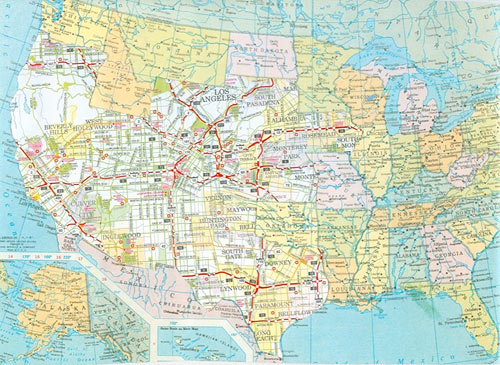
I also liked his alteration to a Chuck Close portrait: Rauschenberg Minus Nebraska.
If the population density of the United States was equal to that of Brooklyn, the entire US population would fit into New Hampshire.
The state would be ruined, though (imagine a Brooklyn-like sprawl of that size), but the rest of the country would be green and pleasantly devoid of people!
If you used Manhattan’s population density, Dense US would shrink to more than half that size, roughly the area of Teton County in Wyoming. Manila, the capital of the Philippines, has the highest population density of any city in the world (111,000 people per square mile)…if the US was that dense, the population would fit into any number of tiny Alaskan islands you’ve never heard of or a square 52 miles on a side.
Lots of information and graphs about the changing eating habits of Americans over the past 100 years. More cheese, fewer eggs, and lots more chicken:
Chicken availability over the past 100 years illustrates the effects of new technologies and product development. Increased chicken availability from 10.4 pounds per person in 1909 to 58.8 pounds in 2008 reflects the industry’s development of lower cost, meaty broilers in the 1940s and later, ready-to cook products, such as boneless breasts and chicken nuggets, as well as ready-to-eat products, such as pre-cooked chicken strips to toss in salads or pasta dishes.
Newer posts
Older posts














Stay Connected